Near East Quiz #2
1/31
There's no tags or description
Looks like no tags are added yet.
Name | Mastery | Learn | Test | Matching | Spaced |
|---|
No study sessions yet.
32 Terms
The Akkadian Empire
2300-2100 BC
Post Akkadian Period
2150-2000 BC
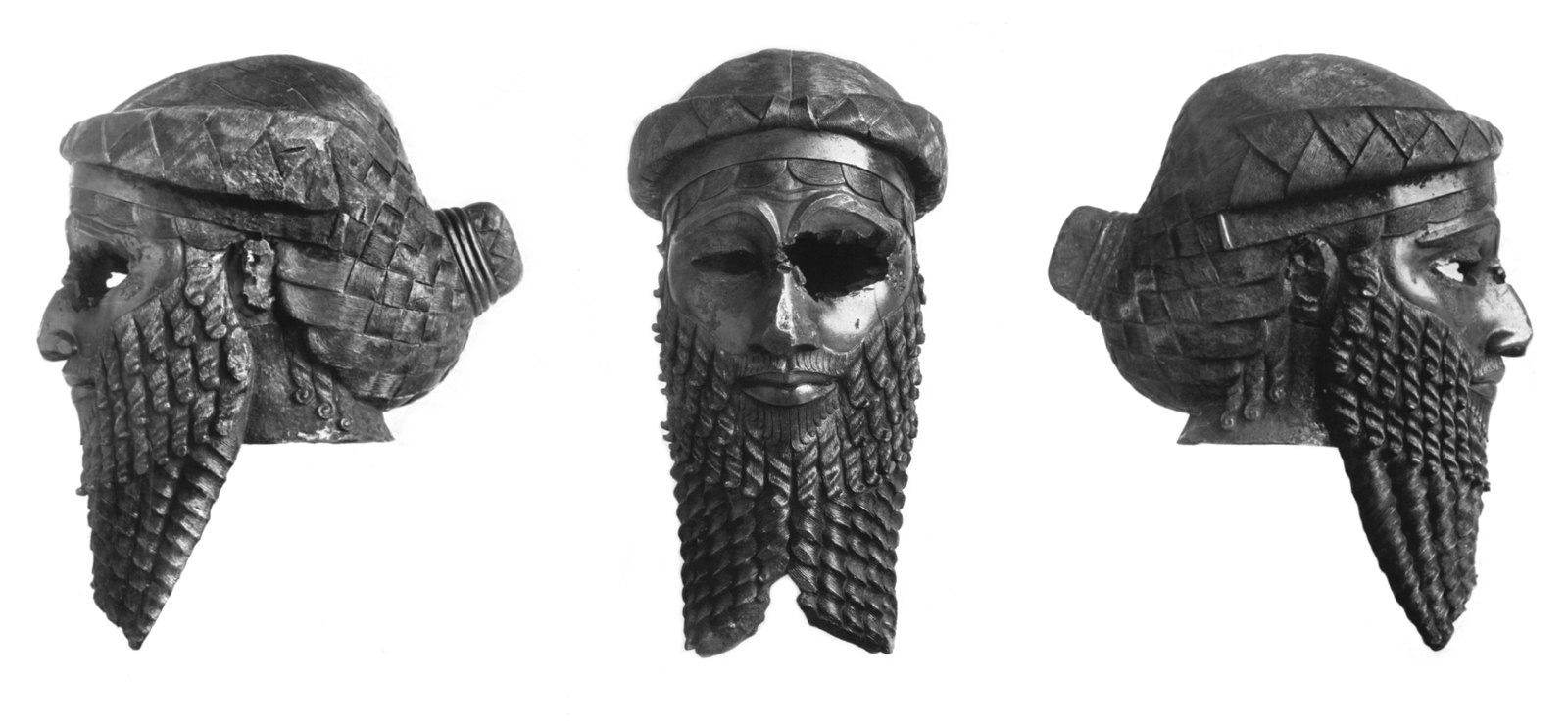
title, date, material, findspot
Head of a King (son of Sargon?)
Akkadian Period, 2300-2100 BC
Bronze or copper alloy
Nineveh, Iraq
Head of a King (son of Sargon?)
Bronze and copper head
Could be Sargon himself? – today we just call it the head of a king
Represents to son of Sargon
Head used to be part of a full body statue
From Akkadian period
Found at Nineveh
Depiction of kingship
It is life size
Arresting in terms of style
Naturalistic
Eyes would be inlaid
Upper lip is carefully shaped
Flaring nostrils
Somewhat stylized, but naturalistic
Meant to convey to power of the king
Standard king iconography: bun, headdress, beard, somber look (naturalistic)
Headdress: rolled cap, echos the helmet of Meskalamdug
Also like to Stele of Eannatum
Beard is important to rulers
Must of been displayed in Akkan or Sumer
Stolen by Assyrians
Missing the inlay of an eye → significant damage to eye
Looks purposely done
Iconoclasm
Nose is also damaged
Bridge of nose
Tip of nose (not purposely done → probably just fell over)
Ears were also damaged
Captured kings (did this in real life – with alive Kings):
Gouged out eyes, cut out tongues, knock off noses, cut off ears
See if he could live with the disabilities
Object biographies
Objects live longer than the people who made them
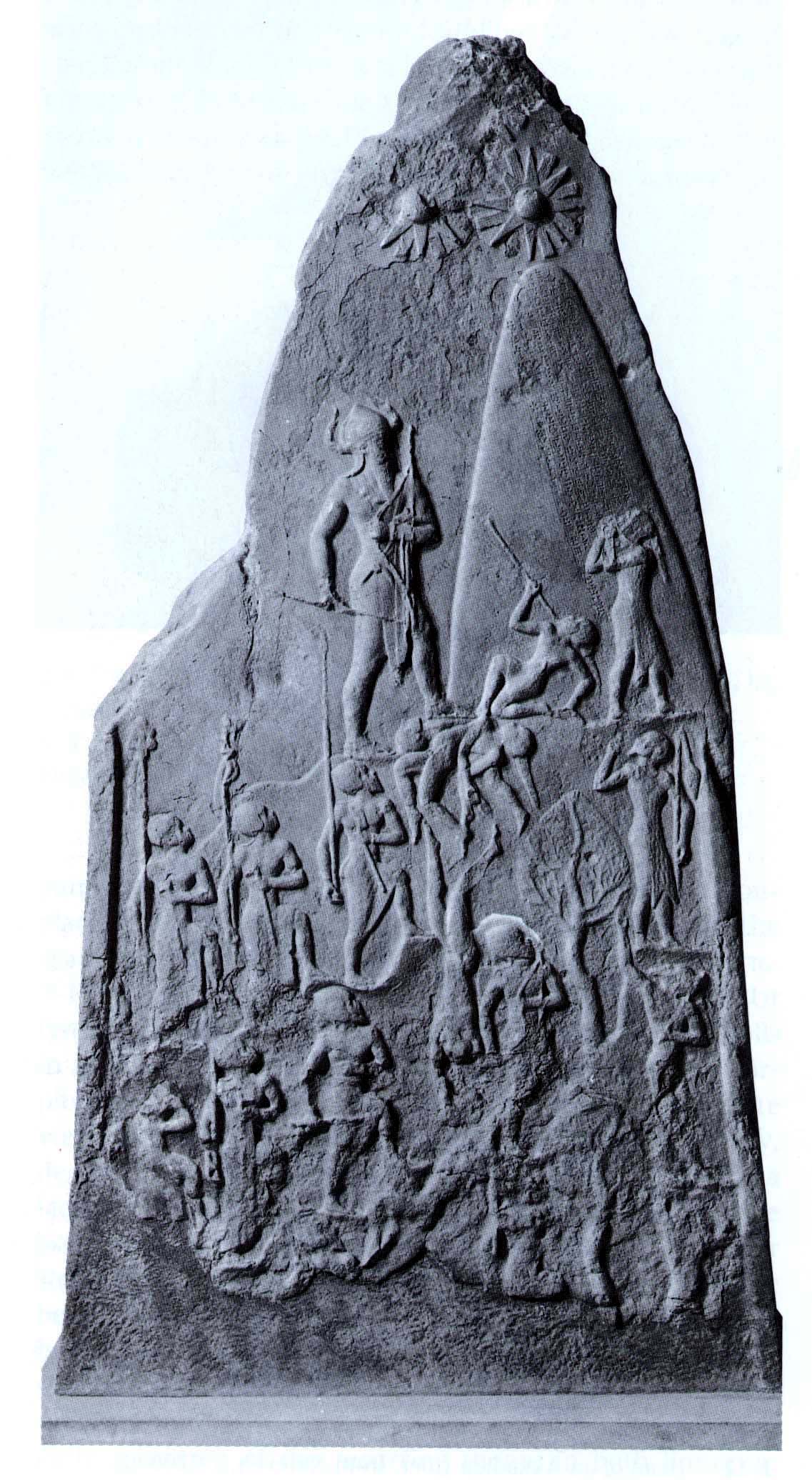
title, date, material, findspot
Stele of Naram-Sin
Akkadian Period, 2300-2100 BC
Red sandstone
Originally from Sippar, excavated in Susa
Stele of Naram-Sin
Important Akkadian work
6’ tall
It records a victory of grandson of Sargon
One of the most famous rulers
Ruled for 65 years
Royal titles of the “King of the four quarters of the world”
During grandson’s reign: cult developed
Monumental stele that captures history
Masterpiece of artistic composition
New representation of the king as a deity
King is not a helper of a god, but now a deity
Made out of a roughly shaped boulder
Used shape of boulder itself
Looks like a mountain – mountain depicted on the “mountain”
Area is largely flat
Iconic congruent
The shape of the object itself has a symbolic meaning of what is depicted on it
Giant heap of enemies
New king Iconography
New helmet (wearing crown with horns coming out of the sides of it)
Above mountain:
(star/flower) Still has support of patron goddess Ishtar
Standard features:
Hieratic scale!
Rolled cap (rim on helmet)
Beard
Standing above a victim (like lion hunt stele)
Above everyone
Horned helmet – usually reserved for deity, still reaching out to patron goddess
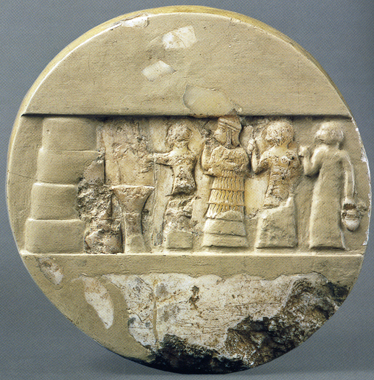
title, date, material, findspot
Disk of Enheduanna, daughter of Sargon
Akkadian Period, c. 2300-2250 BC
Alabaster
Ur, Iraq
Disk of Enheduanna, daughter of Sargon
Fair number of images of women → sometimes empowered women
Important because she is the world’s first named author!!!
Standing nearly at the center of the disk
High priestess of the moon god
Entu – had to be of royal birth – religious, but also political
Controlling things via religion
Cashes of poems and hymns to Ishtar → she signed them
Long after she was dead, they were copied in scribel settings and in schools
Participating in a ritual to the moon god
In front of an altar
Steps → ziggurat
First attendant is pouring a liquid offering on to altar
Attendant behind her is holding a fancy rattle
Last attendant is carrying a spouted jug/vessel
Engaged in a ritual to the moon god
Enheduanna → flounder skirt, curls beside ears (fancy hairstyle), fancy headdress with rolled rim (aga), one arm totally bare/exposed and other arm folded into robe/gown, and she is bigger than everyone else (hieratic scale)
Not married because she is married to the moon god
Had religious roles
Interesting format
Disk in shape of a full moon
Manor of decoration → rolling impression of seal
Found at Ur
Found in a building complex known as the Giparu
Back side:
has an inscription on it and names her
states that she is the high priestess
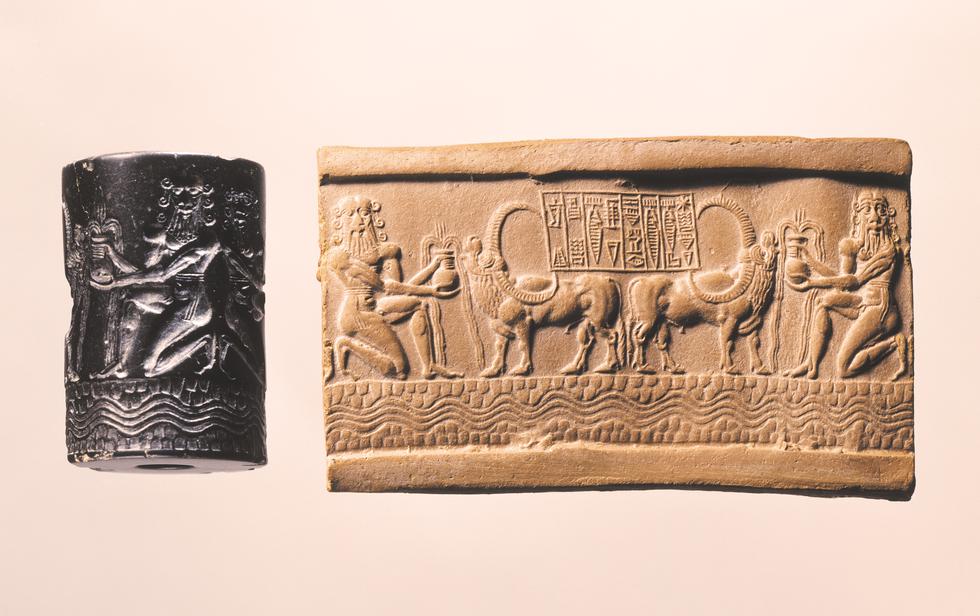
title, date, material, findspot
Seal of Ibni-Sharrum, scribe of Sharkalisharri
Akkadian Period, 2217-2193 BC
Diorite
Unknown — probably southern Iraq
Seal of Ibni-Sharrum, scribe of Sharkalisharri
Akkadian empire fell
Internal descent, invaders on the edges
Around 2160 BCE is often referred to as the Post-Akkadian Period as well as the Gudean Period
Telloh/Lagash is a big city-state

title, date, material, findspot
Statue of Gudea
Post-Akkadian Period, c. 2150 BC
Diorite
Girsu, Iraq
Statue of Gudea
Gudea (ruler)
Under Gudea, things got better → lots of literature and arts, especially sculptures
Gudea paved the way for Sumerian culture (Neosumerian period)
Found in temples
All have very standard iconography
either standing or seated
Folded arms
Bare headed or wearing woolen cap
All wearing woolen shawl that is wrapped around the body (cylindrical form)
One arm is left bare and other is covered
Stocky and muscular
Muscles are shown even under the cloak/shawl
Carved from diorite that gets polished
Looks more religious
Divine authority
Many are inscribed
Talk in the first person
Common thing in antiquity
Some statues are found in a palace at Girsu from Parthian kings
Made his palace out of bricks that were stamped with impressions of Gudea
Sitting with a plan of a map in his lap
2100 year old plan of a temple building
Pius act to build this temple
Shows that he is the patron of the temple
Not everybody could read, so the map/plan shows what he is the patron of
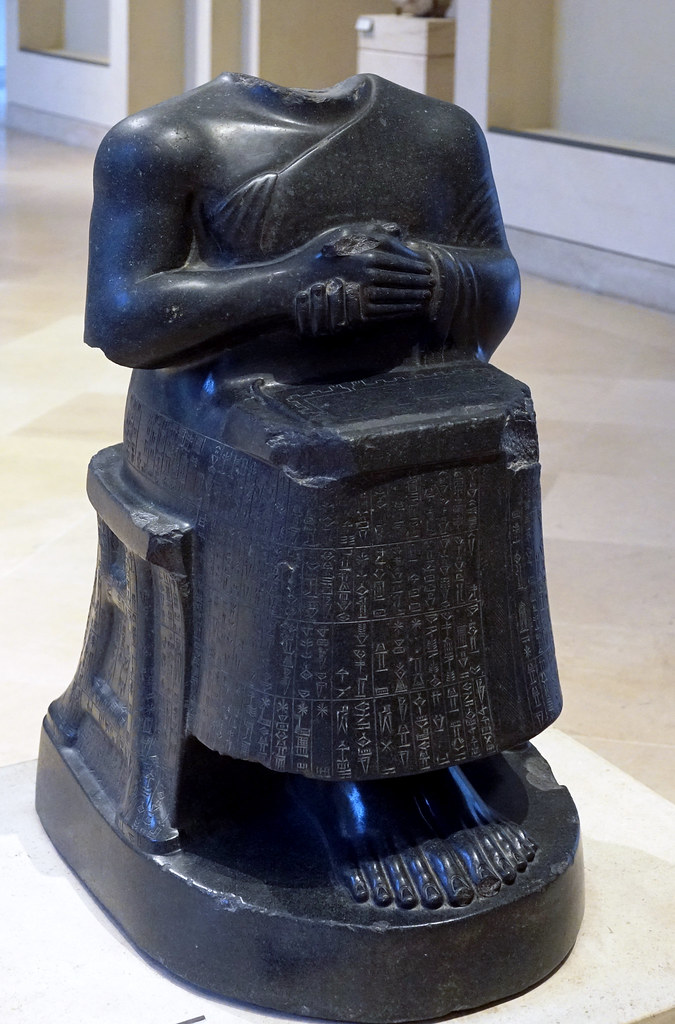
title, date, material, findspot
Gudea Holding the Plan of a Building
Post-Akkadian Period, c. 2150 BC
Diorite
Girsu, Iraq (height: 36.5 inches)
Gudea Holding the Plan of a Building
Gudea (ruler)
Under Gudea, things got better → lots of literature and arts, especially sculptures
Gudea paved the way for Sumerian culture (Neosumerian period)
Found in temples
All have very standard iconography
either standing or seated
Folded arms
Bare headed or wearing woolen cap
All wearing woolen shawl that is wrapped around the body (cylindrical form)
One arm is left bare and other is covered
Stocky and muscular
Muscles are shown even under the cloak/shawl
Carved from diorite that gets polished
Looks more religious
Divine authority
Many are inscribed
Talk in the first person
Common thing in antiquity
Some statues are found in a palace at Girsu from Parthian kings
Made his palace out of bricks that were stamped with impressions of Gudea
Sitting with a plan of a map in his lap
2100 year old plan of a temple building
Pius act to build this temple
Shows that he is the patron of the temple
Not everybody could read, so the map/plan shows what he is the patron of

title, date, material, findspot
Foundation Figure
Post-Akkadian Period, c. 2150 BC
Copper alloy
Probably from Lagash (modern Telloh)
Foundation Figure
Rare example of metal work art from the period
Most of it is lost to us
Deity iconography
Headdress (horns – horned crown – a bunch of horns folded to make hat)
Giant false beard
Rolled waistband
Shoving peg into ground to represent that he is grounding the temple
Rooting or grounding the temple foundation
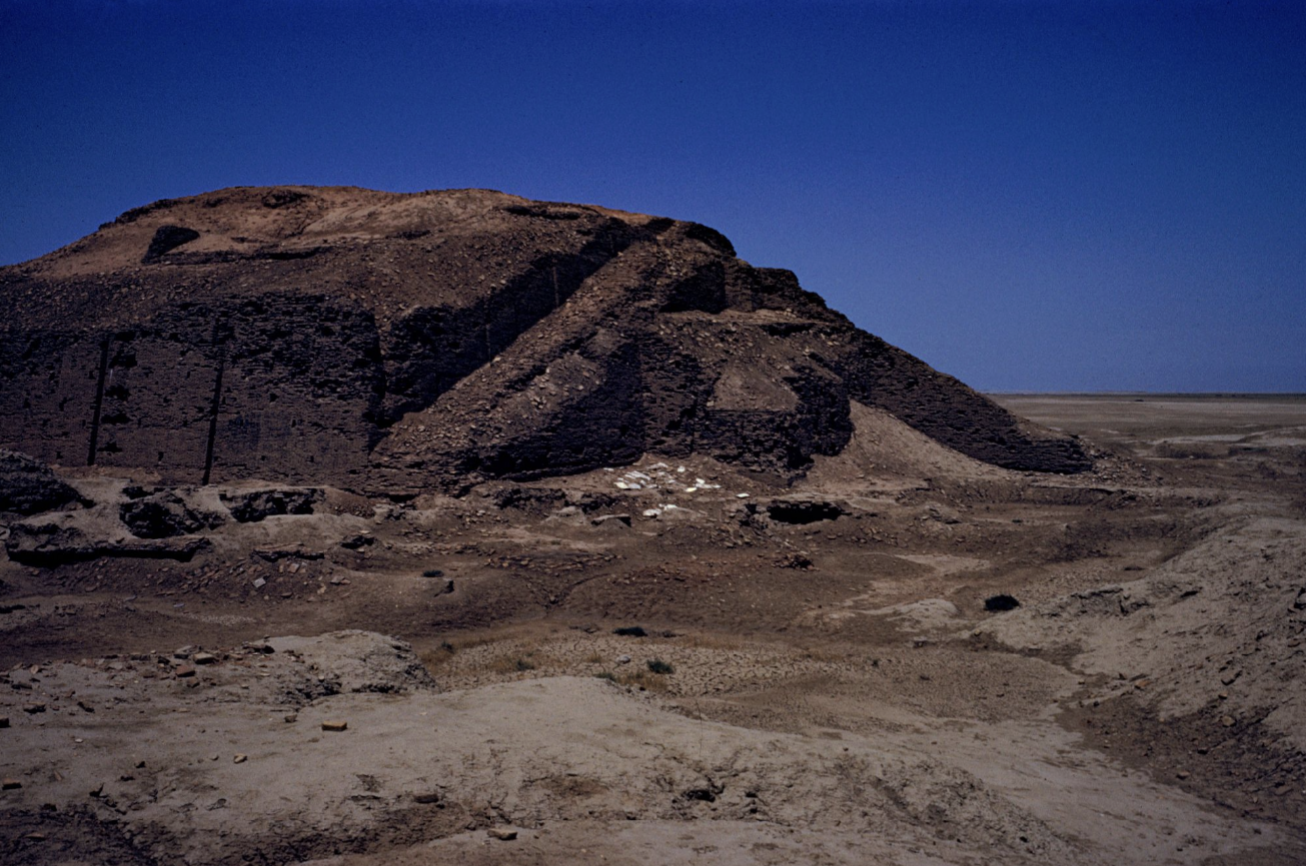
title, date, material, findspot
Ziggurat at Ur
2112-2004 BC
Mudbrick, reed mats, baked mudbrick
Ur
Ziggurat at Ur
Dominated city of Ur became an urban center of Ur
Had fortification walls
In center → Ziggurat
Took 7 years to build temples of similar size
Best preserved ziggurats
Was still made of mudbrick, but encased the exterior with baked clay
In Between the layers of bricks, he inserted mats that were inlaid with clay (bonding – made the building stay up and not be a heap of mud)
Bricks used are stamped with the name Urnamun
Standard features of Ziggurat
Monumental staircase that leads to the entrance
Recesses and buttresses exterior wall
Slanted inward walls
four cardinal points
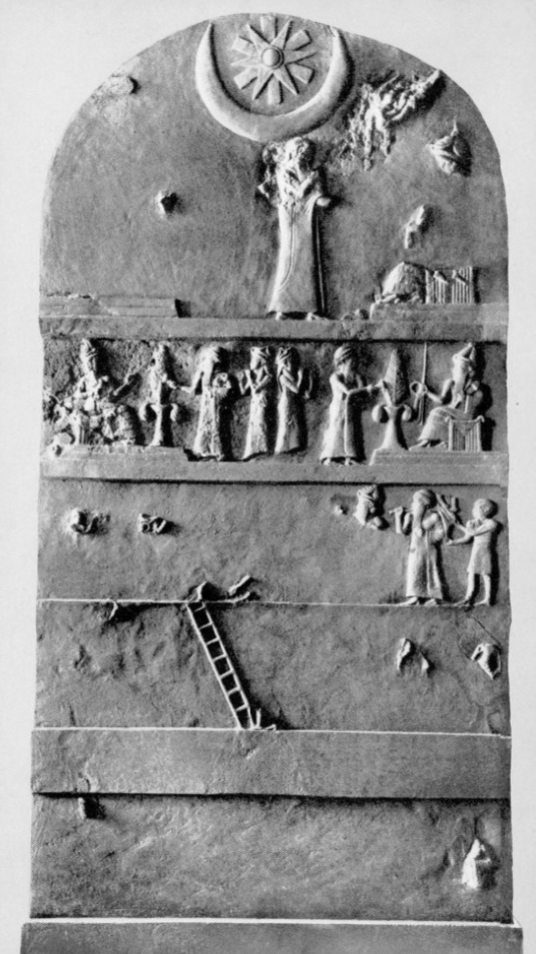
title, date, material, findspot
Stele of Ur-Nammu
Neo-Sumerian Period, 2100-2000 BC
Stone
Ur
Stele of Ur-Nammu
Controversy on where the original pieces have been placed and where they went
At the top of Stele is the crescent moon of Nanna → moon god
Solar symbol
Below it is a ruler that is approaching a deity
Image is being repeated
The deity is on the 4th layer (layer below the top)
Horned crown
Can see multilayered horn crown
Flounced skirt
Holding stuff in his hand
Extending a rod (like measuring stick) and ring (coil of rope)
Symbols of justice
Building materials
Urnamu approaching deity and deity is extending symbols
Register below:
Can see Urnamu
Carrying a bag with tools on his back → tools for building
Building a Ziggurat or temple of the moon/flower(or sun) → moon god (Nanna)
Do you read it bottom to top?
A lot of emphasis on building
Not focused on an individual → now back to a pius king or priest king that was seen in protoliterate period
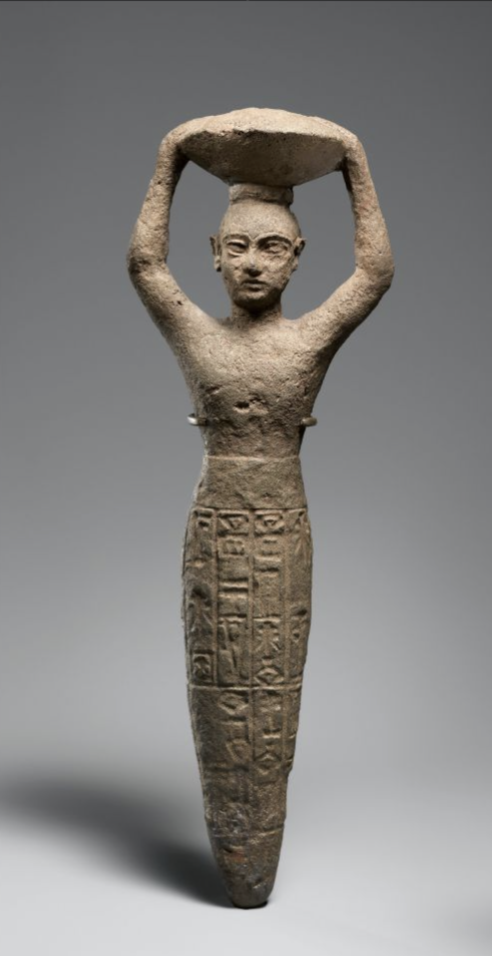
title, date, material, findspot
Foundation figure of Ur Nammu
Third Dynasty of Ur, 2112-2004 BC
Copper alloy
Nippur, Iraq
Foundation figure of Ur Nammu
Grounding temple to the earth
Carrying tools on head to build
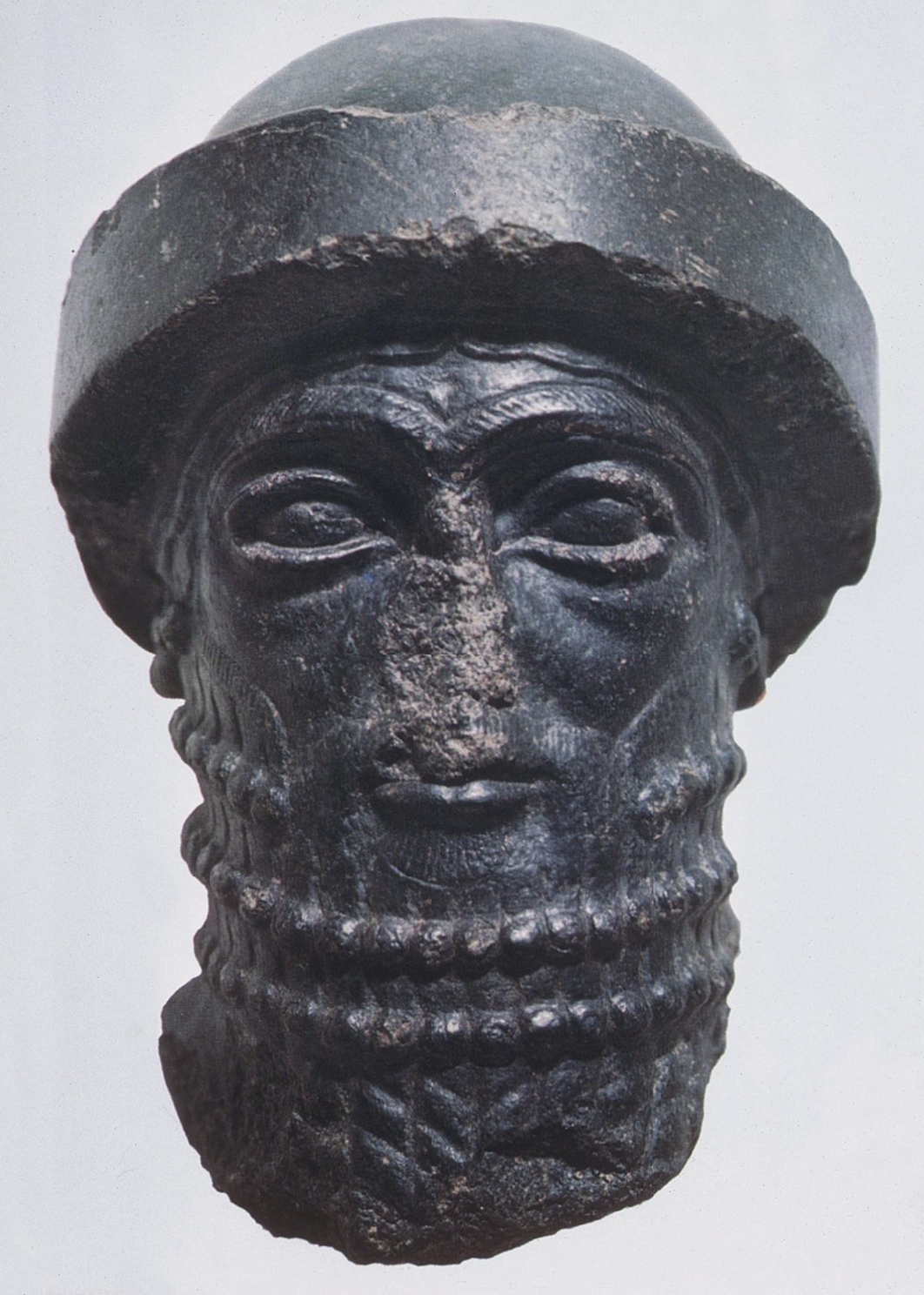
title, date, material, findspot
Head of a King (possibly Hammurabi)
Old Babylonian Period, 1894-1595 BC
Diorite
Provenance unknown
Head of a King (possibly Hammurabi)
Rolled cap (wide rim around it)
Stylized beard
Connected, furrowed eyebrows
Stylized hairstyle peeking out from under the cap
Dealing with my pius king
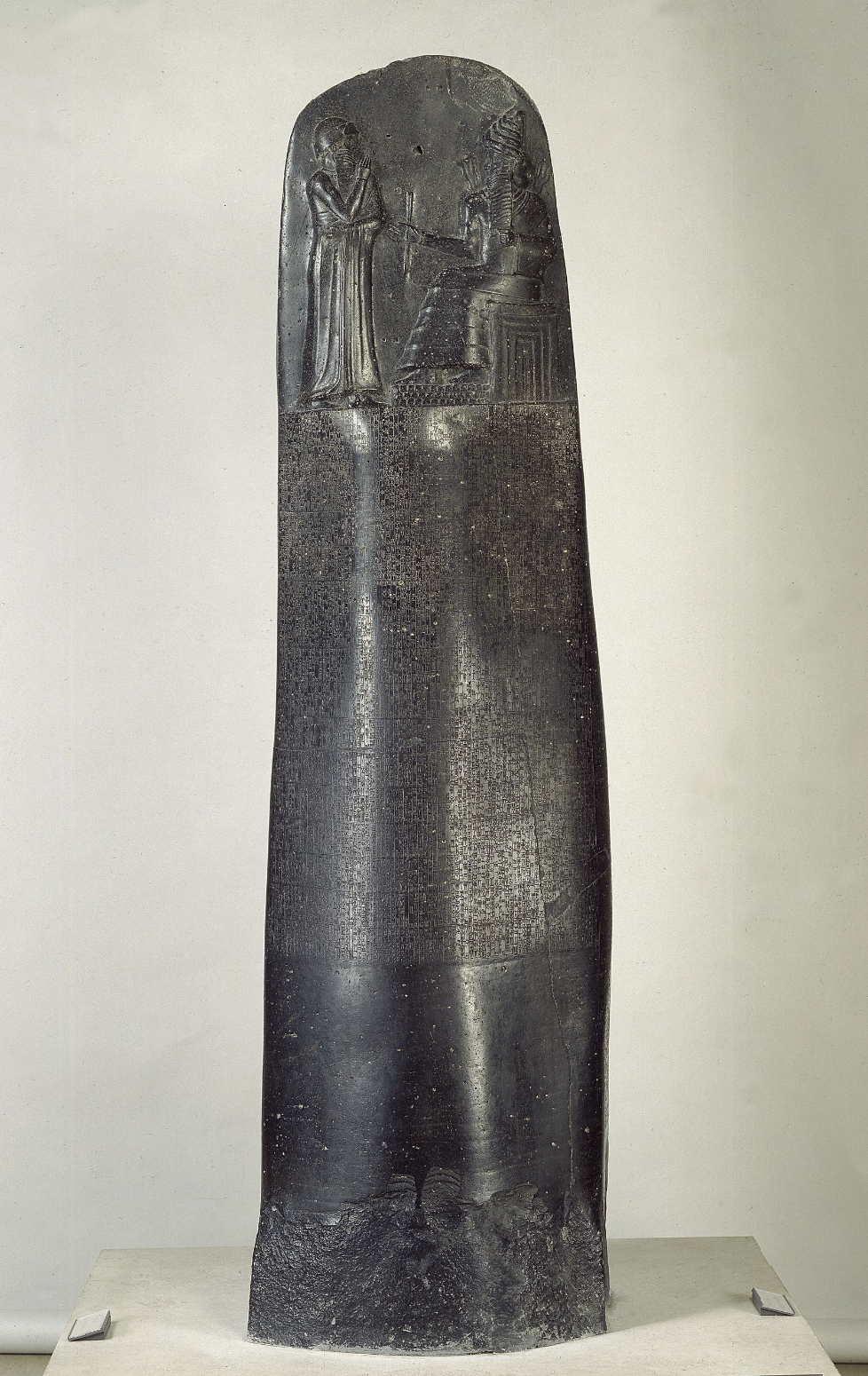
title, date, material, findspot
Law Code of Hammurabi
1706 BC
Black basalt
Originally erected in Babylon
Excavated in Susa, Iran
Law Code of Hammurabi
From old Babylonian Period
Made out of black basalt → comes from the site of Susa
8 feet tall
Records one of the earliest law codes known
Relationship between writing and art! (writing and image)
Famous law code of Hammurabi
classist
Laws added are strict and severe punishments (being thrown into water to drown)
Eye for an eye, tooth for a tooth
Stated in the Bible (Old Testament)
Punishment has to fit the crime – has to be even
Preamble and epilogue is in the first person
“Called me…”
Gender of the offender
Law code is not just text, but includes an image
Depicts Hammurabi
Standard scene
king/worshipper standing before a deity
Hammurabi is standing before the sun god
Hammurabi:
Rolled cap with wide rim
Religious gown that leaves one arm covered and one arm bare
Stylized beard (long that could be attached) and stylized hair peeking out from the hat
Standard convention of representing people in profile (now have profile eyes)
Pray motion → gesture of hand near face → religions, pius, stance
Shamash (Sun God):
Multi-horned helmet
Feet are raised up above the ground
Little squares on foot stool → meant to be mountains
Seated god is as tall as Hammurabi → hieratic scale
If stood up, he would be above the stele
Holding a rod and ring
Extending symbols of justice
Handing them to Hammurabi
Visual depiction of what the preamble says
Something coming off of his shoulders → rays because he is the sun god
Skirt is flounced
Separates the deity from the king
Religious gown that leaves one arm covered and one arm bare
Throne is meant to look recessed and buttressed
Like a facade of his temple
Parallels to Moses receiving the 10 commandments
There is an image to show:
power and authority
people couldn’t read
Shape:
Conceived of a body
Rounded shape (like gown/cloak Hammurabi is wearing)
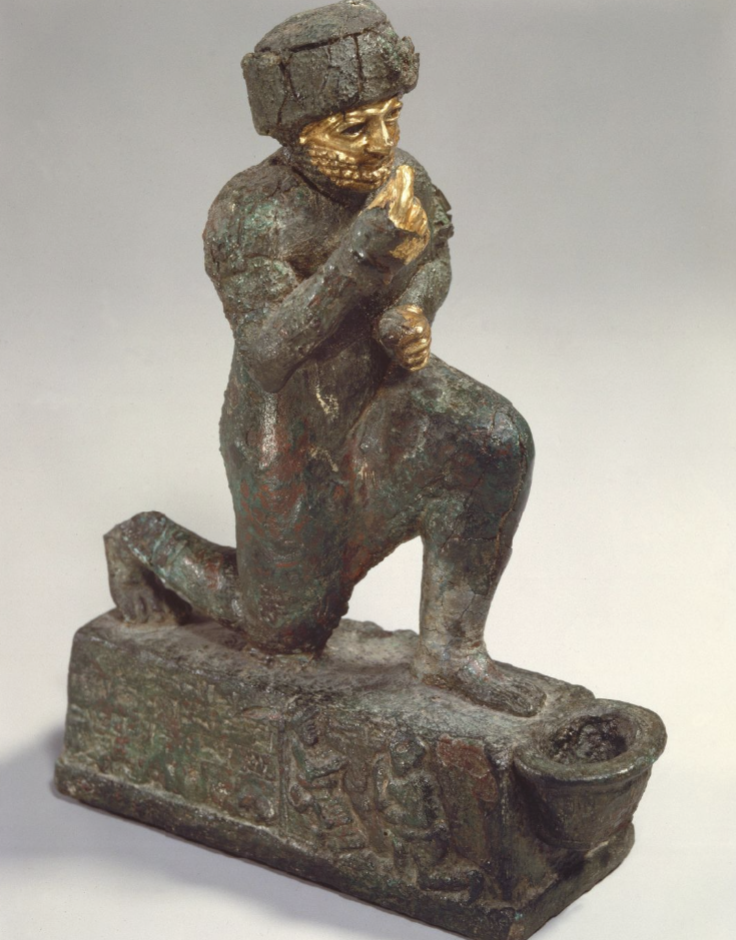
title, date, material, findspot
Votive Statue dedicated by Lu-Nanna
c. 1705 BC
Copper and gold
Larsa, Iraq
Votive Statue dedicated by Lu-Nanna
Small statuette of a worshipper
Dedicated (votive) to a temple meant to depict this worshipper
Meant to represent individual (which is inscribed – Lu-Nanna)
Iconography:
Kneeling
Copper, but some gold overlay (on face and hands)
Gesture → arm to his face, has forefinger and thumb put together (which means prayer)
Rolled cap with wide rim and stylized beard
Base:
Basin (in order to hold liquid or incense)
Inscription of dedicator and to whom this was dedicated to
Made this for the life of Hammurabi and in support for his own life
Inscription talks about material of statue
Relief → seeded deity
Pieces of flounced skirt
In front of deity, there is a guy on his knee in same position
Hypericon
Very self conscious
Example: Uruk Vase, Harp from Ur
In 1762, Hammurabi conquered city of Mari
Before that Hammurabi had a positive diplomatic ruling with the ruler of Mari
Palace at Mari
Fabled palace – wonder of the time
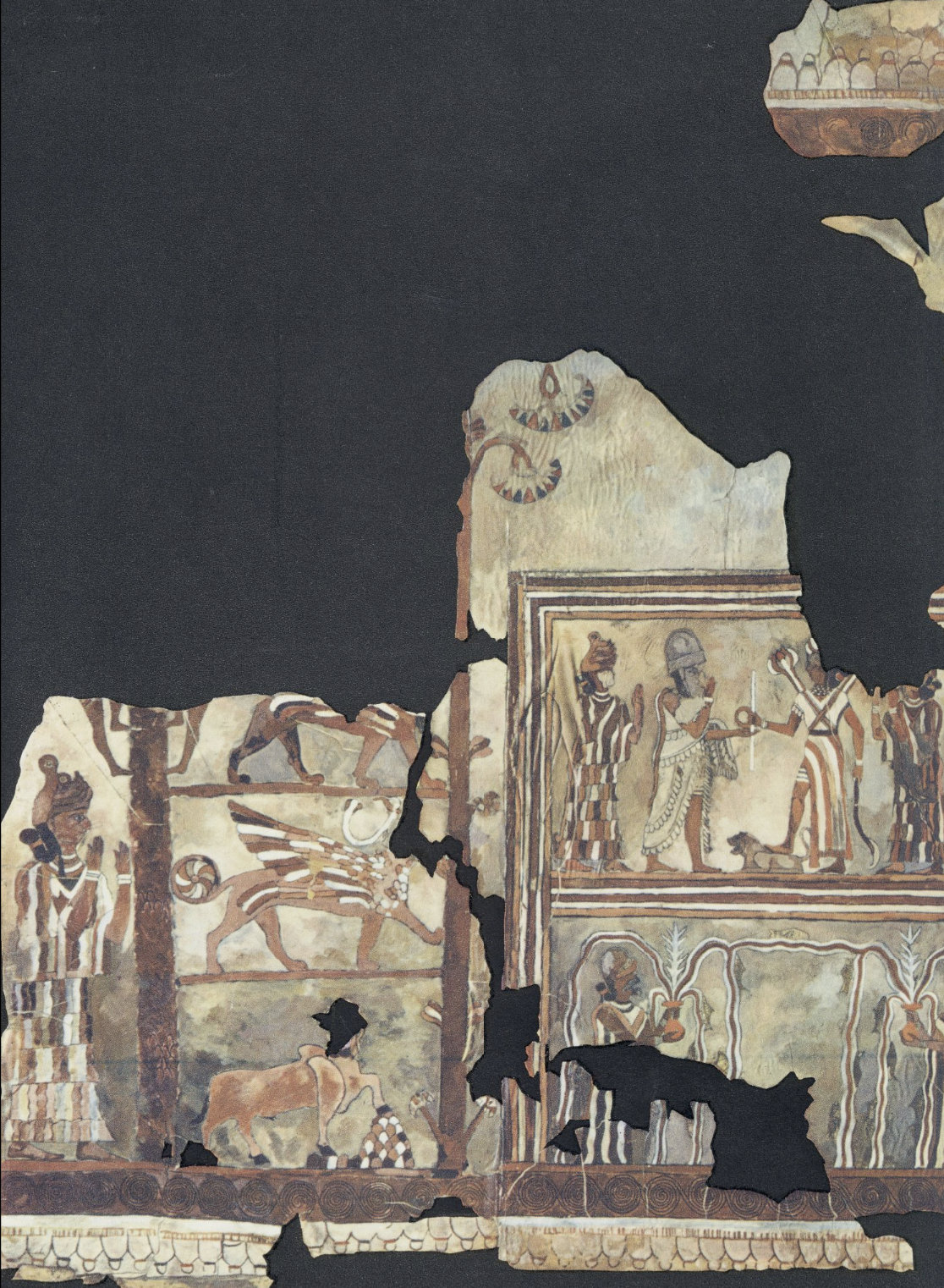
title, date, material, findspot
Investiture of Zimri-Lim
(from Court 106)
c. 1708 BC
Tempera
Palace of Zimri-Lim, Mari, Syria
Investiture of Zimri-Lim
Giant palace built during the NeoSumerian period
Famous throughout the entire Near East because it was so humongous
Over 250 rooms
So famous that there are literary pieces talking about this palace
Palace was the center of libraries and culture, as well as an administrative center
Example of how big the Old Babylonian was
Palace was actually built in NeoSumerian period
Enormous!
Had over 260 rooms
Under many monarchs
Fresco from outside the writing room
Conquered in 1762 BC → becomes Hammurabi’s territory
Zimri-Lim ruled 1775-1762 BCE
Did a lot of renovations on this palace during his time of living here
Giant fresco found in room C → outside of throne room (room D)
Court area that goes into to see the King
Investiture of Zimri-Lim
Shows goddess of Ishtar handing rod and the ring to Zimri-Lim
Goddess iconography
Rays coming out of shoulders
Foot is on top of animal (it is not a footstool, it is a lion)
Deities have specific animals → Ishtar’s animal is a lion
Clearly part of program of propaganda to show when this king was put into power and by whom the king was put into power
Rule is divinely
Frescos are “true frescoes”
Paint was applied to a wet base
Painted on wet plaster → considered true fresco
Earliest true fresco anywhere in the world
“True fresco” → fresh
Paint goes on wet/fresh plaster
Form a chemical bond that the paint doesn’t fall off the surface
Neo-Sumerian Period (Third Dynasty of Ur)
2112-2004 BC
Old Babylonian Period
1894-1595 BC